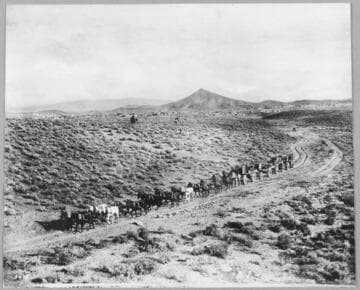Rare Books
Routes of the Twenty Mule Teams : Twenty Mule Team and other borax transportation routes
You might also be interested in

Twenty mule team hauls borax to railroad
Visual Materials
A 20 mule team pulling two wagons of borax with three riders on the wagons.
photCL Pierce 06565

Teaming the borax out of Death Valley
Visual Materials
Twenty mule team pulling two wagons of borax.
photCL Pierce 06566

24 mules on Puente grain field
Visual Materials
Image of a twenty four mule team pulling a combine harvester through a grain field in La Puente, California, with farmers standing on top and sacks of grain being filled and stacked on the harvester. The Puente Hills are in the distance.
photCL_555_01_651

Hauling supplies to the Mines. 20 horse and mule teams, Goldfield, Nevada. 1905
Visual Materials
A view of a 20 mule and horse team coming around a bend in a dirt road with Goldfield in the background.
photCL Pierce 06471
Image not available
Ten Mules Borax Team of Hank Hawn (c.1912). 3 items
Manuscripts
The collection contains Frank F. Latta's research material from his five decades of researching the history of California's San Joaquin Valley and Miller & Lux, in particular dry farming known as skyfarming. Subjects include: agriculture and farming in the San Joaquin Valley, the development of agricultural machinery (combines, plows, reapers, scrapers, threshing machines, tractors and various types of harvesters), livestock, ranches, cattle, and crops, mostly wheat. Also covered are: early aviation, early automobiles, bears, crime, the Dalton Gang, the Donner Party, earthquakes, education and schools in the San Joaquin Valley, floods, freight and steamships on the San Joaquin River, gold mines, irrigation, canals and water rights in San Joaquin Valley, land grants, livestock, lumber, outlaws, pioneers, the Presbyterian Church in California, ranches, rivers, roads, saddlery, sheepherding in California, overland journeys to California and California politics, government and history. Also talked about are women, African Americans, Chileans, Chinese, Mormons, Native Americans and Jews in California. The collection contains roughly 180 oral interviews with people living in the San Joaquin Valley in the 1930s through the 1970s. One of the series contains drafts of the unpublished manuscript Sky Farmers and Mule Skinners with Something about Hay Muckers, Buckaroos, and Bindle Stiffs and a Sheepherder or Two. Frank F. Latta worked on this manuscript for five decades.
mssLattaS
Image not available
Mule team in mountains
Visual Materials
A collection of photographs documenting miner Robert S. Watt and family living in the mountains of Los Angeles County at the turn of the 20th century. Views show daily activities and places visited; people hunting and living in cabins; horses; and a few group portraits, such as Los Angeles County Hospital Nurses on a picnic (1905) with names written on back. Other views show ships and a harbor, possibly in San Pedro, California; Los Angeles buildings (Plaza Church and County Courthouse) and oil wells. Mining scenes include the Watt Mines Supply Co. building in Los Angeles; men at an excavation; stamp mill machinery; a man standing at entrance to mine; and mule teams with supplies. There is also a group of photographs of Alaska, showing trappers, roadhouses, scenery, and a miner staking a claim on a river. There are also two U.S. citizenship certificates for Robert S. Watt (1890) and Alexander Barrie (1901), emigrants from Scotland.
photCL 395